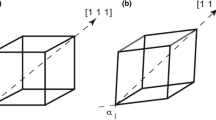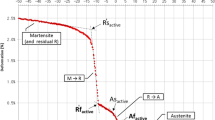Abstract
A previous paper (Duerig and Bhattacharya in Shap Mem Superelasticity 1:153–161, 2015) introduced several engineering considerations surrounding the R-phase in Nitinol and highlighted a common, if not pervasive, misconception regarding the use of the term Af by the medical device industry. This paper brings additional data to bear on the issue and proposes more accurate terminology. Moreover, a variety of tools are used to establish the forward and reverse stress–temperature phase diagrams for a superelastic wire typical of that used in medical devices. Once established, the two most common methods of measuring transformation temperatures, Differential Scanning Calorimetry and Bend Free Recovery, are tested against the observed behavior. Light is also shed upon the origin of the Clausius–Clapeyron ratio (dσ/dT), the triple point, and why such large variations are reported in superelastic alloys.




















Similar content being viewed by others
Notes
While this is often written as dσ/dT = − ∆H/TΔ∆ε, care must be taken in that ΔH here is not the latent heat of transformation but includes strain energy considerations.
Even in the absence of Lüders deformation, care must be taken in assuming that the plateau length is a measure of transformational strain. Neutron diffraction experiments have demonstrated that transformation continues well beyond the apparent end of the plateau [13]. Further evidence for this is seen in the temperature dependence of the plateau lengths in Fig. 3. It should be further noted that bands of Martensite do contain some small amount of retained Austenite, and some Martensite can still be found outside of the bands.
Not that, this midpoint stress value could be different from the unloading stress values dictated by ASTM F2516. Here, we are invoking thermodynamic principles, whereas the ASTM standard provides a convenient, yet arbitrary, strain (2.5%) to select an unloading stress..
Extracting the \(M_{\text{s}}^{*}\) temperature is difficult because shape recovery is so gradual. One must project the recovery profile to estimate the horizontal tangent, as shown in this figure. The alternative of drawing a tangent to the tail of recovery is even more problematic since then the temperature at which one begins to record data dictates the slope of the tangent.
.
References
Duerig TW, Bhattacharya K (2015) The influence of the R-phase on the superelastic behavior of NiTi. Shap Mem Superelasticity 1:153–161
A Shamimi, B Amin-Ahmadi, A Stebner and TW Duerig, The Effect of low temperature aging and the evolution of R-phase in Ni-rich Ni-Ti, to be published
Reedlunn B, Churchill CB, Nelson EE, Shaw JA, Dally SH (2012) Tension, Compression, and Bending of Superelastic Shape Memory Alloy Tubes. J Mech Phys Solids 63:506–537
McNaney JM, Imbeni V, Jung Y, Papadopoulos P, Ritchie RO (2003) An experimental study of the superelastic effect in a shape-memory nitinol alloy under biaxial loading. Mech Mater 35:969
Sun QP, Li Z-Q (2002) Phase transformation in superelastic NiTi polycrystalline micro-tubes under tension and torsion—from localization to homogeneous deformation. Inter J Solids Struct 39(13):3797
Otsuka K, Ren X (1999) Physical metallurgy of ti-ni-based shape memory alloys. Intermetallics 7:511
Ling HC, Kaplow R (1981) Stress-induced shape changes and shape memory in the R and martensite transformations in equiatomic NiTi. Met Trans 12A:2101
Miyazaki S, Otsuka K (1986) Deformation and Transformation Behavior Associated with the R-phase in Ti-Ni Alloys. Met Trans A 17:53–63
Wang X, Kustov S, Verlinden B, Van Humbeeck J (2015) Fundamental Development on Utilizing the R-phase Transformation in NiTi Shape Memory Alloys. Shap Mem Superelasticity 1(2):231
Helbert G, Saint-Sulpice L, Chirani SA, Dieng L, Lecompte T, Calloch S, Pilvin P (2017) A uniaxial constitutive model for superelastic NiTi SMA including R-phase and martensite transformations and thermal effects. Smart Mater Struct 26:1
ASTM Designation: E6—09b, Standard Terminology Relating to Methods of Mechanical Testing
ASTM Designation: F 2004—05, Standard Test Method for Transformation Temperature of Nickel-Titanium Alloys by Thermal Analysis
Stebner AP, Paranjape HM, Clausen B, Brinson LC, Pelton AR (2015) In situ neutron diffraction studies of large monotonic deformations of superelastic nitinol. Shap Mem Superelasticity 1:252–267
ASTM Designation: F 2082—06, Standard Test Method for Determination of Transformation Temperature of Nickel-Titanium Shape Memory Alloys by Bend and Free Recovery
Bogdanoff PD, Fultz B (2001) The role of phonons in the thermodynamics of the martensitic transformation in NiTi. Philos Trans B 81:299
Stebner AP, Vogel SC, Noebe RD, Sisneros TA, Clausen B, Brown DW, Garg A, Brinson LC (2013) Micromechanical quantification of elastic, twinning, and slip strain partitioning exhibited by polycrystalline, monoclinic nickel-titanium during large uniaxial deformations measured via in situ neutron diffraction. J Mech Phys Solids 61(11):2302–2330
Cai S, Schaffer JE, Ren Y, Yu C (2013) Texture evolution during nitinol martensite detwinning and phase transformation. Appl Phys Lett 103:241909
Author information
Authors and Affiliations
Corresponding author
Rights and permissions
About this article
Cite this article
Duerig, T.W., Pelton, A.R. & Bhattacharya, K. The Measurement and Interpretation of Transformation Temperatures in Nitinol. Shap. Mem. Superelasticity 3, 485–498 (2017). https://doi.org/10.1007/s40830-017-0133-0
Published:
Issue Date:
DOI: https://doi.org/10.1007/s40830-017-0133-0




